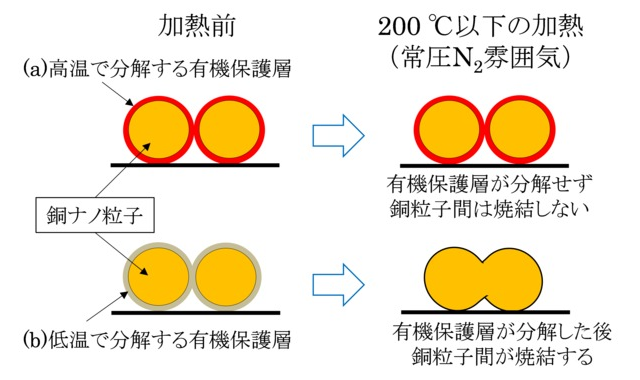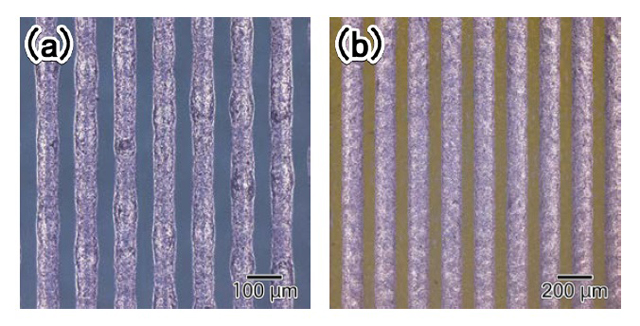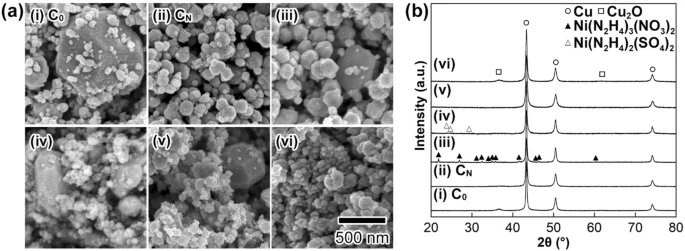

通过将显影的铜纳米膏丝网印刷在薄膜上然后在 200°C x 30 分钟下烧制(在氮气气氛中常压烧制)获得的布线相图。
(a): PEN 薄膜上的布线形成, (b): PI 上的布线形成

三井金属:可低温烧结的铜纳米粒子:银浆的替代品
-新的无有机合成铜细颗粒-
~ 实现使用水溶性贱金属盐的绿色合成方法 ~
东北大学综合材料科学研究所
三井矿山冶炼研究所
开发了“可作为导电材料的铜微粒”的“无有机合成工艺”。
这次开发的合成方法:
铜微粒是使用水溶性贱金属盐合成的。
得到的铜微粒为
因为它不含有机物
燃烧时产生的气体很少
证实它在低温下烧结。
创新合成技术:
这种方法是
可望成为“实现可持续社会的创新合成技术”。
此外,
可以创造出具有前所未有的新功能的金属微粒。
这个结果:
它于12月20日发表在nature.com的开放获取电子期刊“科学报告”上。 (DOI: 10.1038 / s41598-021-03707-9)
公告摘要:
有机游离铜粒子合成工艺
(铜前驱体湿法还原法)
我们新开发了一种不含有机物的铜颗粒合成工艺。
使用贱金属盐,
水下、大气下、室温下
在低环境负荷条件下
可以合成铜微粒。
节约资源、节能的合成方法:
与使用有机物的常规方法相比,它是一种资源节约和节能的合成方法。
下一代电子产品的导电材料:
合成铜微粒不含有机物。
因此,燃烧时产生的气体非常少。
可以预期下一代电子产品作为导电材料的应用。
【概述】
铜微粒比金、银等贵金属微粒元素丰富,价格便宜。
它具有与贵金属相同的高导电性和导热性。
以往铜粒合成方法:
然而,在传统的铜粒子合成方法中,添加和使用有机物质,并且需要对其进行分解处理。
三井金属与东北大学/“低温可烧结铜纳米粒子”的开发/银浆替代品的期待 | 日刊钢铁报 Japan Metal Daily
https://engineer.fabcross.jp/archeive/190201_tohoku.html
A mild aqueous synthesis of ligand-free copper nanoparticles for low temperature sintering nanopastes with nickel salt assistance
Scientific Reports
Abstract
An organic ligand-free aqueous-phase synthesis of copper (Cu) nanoparticles (NPs) under an air atmosphere
was successfully achieved by reducing copper(II) oxide particles with a leaf-like shape in the presence of Ni salts at room temperature.
The resulting Cu NPs with a mean particle diameter of ca. 150 nm
exhibited low-temperature sintering properties due to their polycrystalline internal structure and ligand-free surface.
These Cu NPs
were applied to obtain Cu NP-based nanopastes with low-temperature sintering properties,and the resistivities of the obtained Cu electrodes after annealing at 150 °C and 200 °C for 30 min were 64 μΩ∙cm and 27 μΩ∙cm, respectively.
The bonding strength between oxygen-free Cu plates prepared using the Cu NP-based nanopastes
reached 32 MPa after pressure-less sintering at 260 °C for 30 min under a nitrogen atmosphere.
The developed manufacturing processes using the developed Cu nanopastes
could provide sustainable and low-CO2-emission approaches
to obtain Cu electrodes on flexible films and high-strength bonding between metal plates as die-attach materials for power devices under energy- and resource-saving conditions.